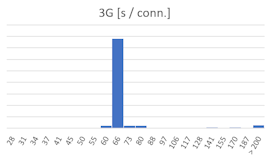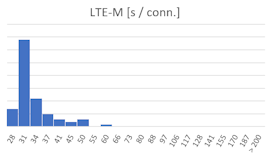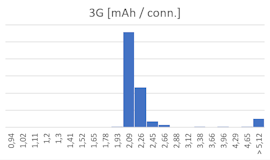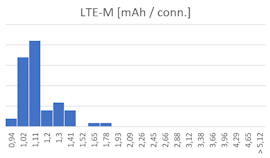![]() When you must design a system that sends back measures through a GSM connection, there are two physical quantities that you want to estimate: que quantity of transferred data and the power consumption. We already had the opportunity to provide orders of magnitude for data consumption in a previous post, but we are going to see today how much power is needed to send back data periodically through a 3G or 4G GSM connection.
When you must design a system that sends back measures through a GSM connection, there are two physical quantities that you want to estimate: que quantity of transferred data and the power consumption. We already had the opportunity to provide orders of magnitude for data consumption in a previous post, but we are going to see today how much power is needed to send back data periodically through a 3G or 4G GSM connection.
When it comes to saving energy, the basic principle consists in keeping as much as possible the electronics in a sleeping state and to wake it only briefly for communication purposes. You can do so with the modules thanks to the clock embedded in Yoctopuce GSM hubs, exactly as we described it for Wifi hubs in another post dedicated to measures in the middle of nowhere.
Warning ! If you bought a YoctoHub-GSM-4G before September 2021, read the following paragraph carefully:
Update your YoctoHub-GSM-4G firmware!

To limit these risks, we improved the power down sequences of the u-Blox module in firmware 45886 of the YoctoHub-GSM-4G. If you have a prior version, you must imperatively update it, otherwise each time the modules switches to sleep mode (or each restart of the module, if you configured a downtime to reboot) represents a risk of fatal corruption of the u-Blox module.
By the way, we have now received a new version of the u-Blox module which is much more robust to brown-out conditions and should also greatly reduce this risk.
Connection time
The energy consumption of the system therefore depends primarily on the switch-on time required to establish communications and transmit data. This time can vary slightly depending on the cell provider and the availability of relay antennas, but we can nevertheless observe a rather different order of magnitude depending on the technology used. The graph below shows the time necessary for powering up, establishing the GSM data line, transmitting of all the data for the hub and a Yocto-Meteo sensor using HTTP callback in Yocto-API mode, and returning the system into hibernation.


Distribution of total non-sleep time measures, per transmission
We therefore note that the YoctoHub-GSM-4G (in LTE-M mode) is usually much faster than the YoctoHub-GSM-3G-EU to send measures. By viewing the module logs, we observe that this is not due to the transmission of data itself, but rather to the establishment of the connection with the cell station.
Power consumption
The second factor is naturally the power consumption when the module is awake. If we integrate the instant consumption (in mA) over the connection duration in fraction of hour, we obtain the energy required per transmission (in mAh). This measures sums the energy of the whole system, including the Yocto-Meteo which takes the measures. Here is the comparison between 3G and LTE-M:


Total power consumption in mAh per transmission
The advantage in this case is even clearer for the YoctoHub-GSM-4G.
Which battery size should one use?
With a 5V 3300mAh battery, the LTE-M system measured above could therefore perform 3000 connections. But beware, do not rely directly on the numbers shown on the battery for your computations, you had better read again the post that we dedicated to this topic to avoid being caught short. And most probably, you should use a backup power source, such as a solar panel.


